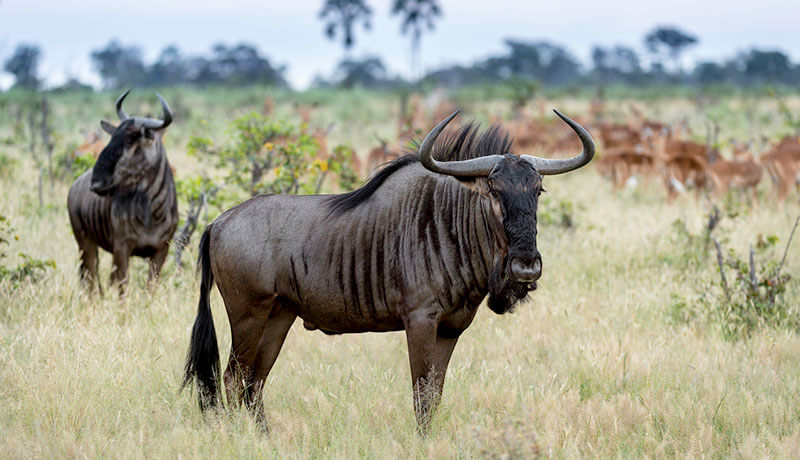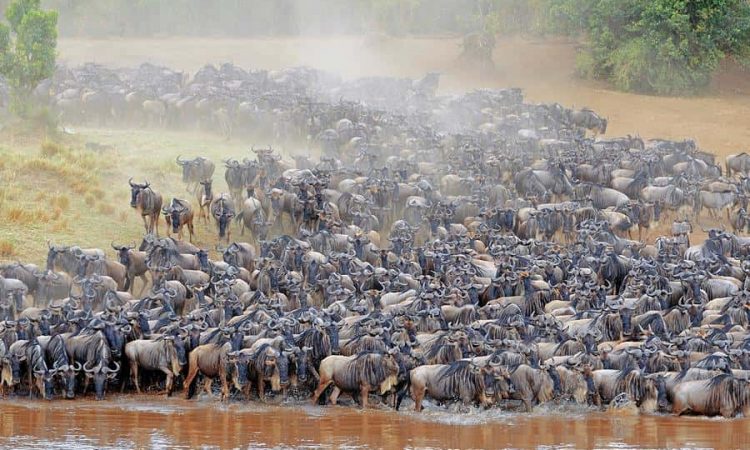The Lifespan of Wildebeest: Nature’s Marathoners
Among Africa’s great plains dwell some of the most resilient creatures on Earth—the wildebeest, or gnu. With their muscular build, curved horns, and unrelenting energy, these grazers embody the spirit of the wild. They are constant travelers, tirelessly crossing the Serengeti and Maasai Mara in search of greener pastures. Yet behind their strength lies a fascinating life story marked by endurance, danger, and instinct. How long does a wildebeest live, and what determines its survival? This is the story of nature’s true marathoners.

The Average Lifespan of a Wildebeest
In the wild, a wildebeest can live up to twenty years, although most rarely reach that age. Life on the open savannah is filled with threats—from lurking predators to seasonal droughts and the perilous river crossings of the Great Migration. Those that live beyond their first few years often develop an impressive stamina that allows them to survive for more than a decade. In captivity, where food is abundant and predators are absent, wildebeest can live as long as twenty-five years. But in their natural environment, every day is a test of endurance, and longevity is a reward only the most fortunate achieve.
Birth and Early Life
The life of a wildebeest begins dramatically on the plains of the southern Serengeti, where between January and March nearly half a million calves are born in near-perfect synchrony. This mass birthing event overwhelms predators and ensures that at least some young survive. Within just five minutes of birth, a calf can stand, and in less than ten minutes it can run alongside its mother—an extraordinary adaptation for survival in such an unforgiving environment. Even so, only about half of these calves make it through their first year. Those that survive soon join the great herds that define Africa’s most spectacular natural event: the Great Wildebeest Migration.

The Great Migration: A Test of Endurance
Each year, over one and a half million wildebeest set out on a journey across Tanzania’s Serengeti and Kenya’s Maasai Mara. This epic migration, stretching more than 1,800 miles, is driven by the search for fresh grass and water. It is a rhythm as old as time—an endless loop of movement and renewal. Along the way, thousands fall prey to lions, cheetahs, hyenas, and crocodiles during river crossings. Others perish from exhaustion, starvation, or disease. Yet this very struggle is what sustains the species. The Great Migration not only ensures access to new grazing lands but also rejuvenates the ecosystem by spreading nutrients and stimulating plant growth. To watch this migration is to witness the essence of survival itself—a breathtaking display of resilience that justifies calling wildebeest “nature’s marathoners.”
Predators and Natural Threats
From the moment they are born, wildebeest live under constant threat. Lions, cheetahs, hyenas, leopards, and wild dogs are their chief predators, while crocodiles lie in wait during the perilous river crossings. Predation during calving season and migration is fierce, and only the strongest or luckiest survive. Apart from predators, other challenges such as drought, disease, and injury also shorten their lifespan. Droughts deplete grasslands, forcing herds to travel longer distances in search of food. Diseases like anthrax or rinderpest can sweep through populations, and injuries sustained during migration often prove fatal. Despite these dangers, wildebeest continue to thrive because of their adaptability, speed, and strong herd instincts.
Adaptations for Survival
Over millennia, wildebeest have evolved remarkable adaptations that enable them to withstand life on the savannah. Their bodies are built for endurance, allowing them to travel thousands of kilometers each year. They have an exceptional memory and sense of direction, which guide them along ancient migration routes followed by generations before them. Their herd behavior provides protection, as predators find it difficult to single out individuals among such massive numbers. Even their digestive systems are highly efficient, enabling them to extract nutrients from short, dry grasses that other herbivores might ignore. These traits, honed by evolution, are the foundation of the wildebeest’s survival and longevity.
Life Expectancy by Species
There are two main species of wildebeest in Africa—the blue wildebeest (Connochaetes taurinus) and the black wildebeest (Connochaetes gnou). The blue wildebeest, famous for its role in the Great Migration, is found across Tanzania, Kenya, and southern Africa. The black wildebeest, on the other hand, inhabits the open plains of South Africa. While both species have similar lifespans of about fifteen to twenty years, the blue wildebeest’s migratory lifestyle exposes it to greater risks, making its survival even more remarkable.
Conservation and the Future of Wildebeest
Today, wildebeest populations remain stable thanks to extensive conservation efforts. More than 1.5 million blue wildebeest roam the Serengeti–Mara ecosystem, and around 250,000 black wildebeest inhabit South Africa’s protected grasslands. National parks such as Serengeti, Maasai Mara, and Ngorongoro provide crucial sanctuaries for these animals, ensuring that migration routes remain open and protected. However, habitat fragmentation, climate change, and expanding human activity continue to threaten their future. Supporting sustainable tourism and conservation programs is essential to preserving their habitats and the natural balance they help maintain.
Final Thoughts
The lifespan of a wildebeest is not measured merely in years but in the sheer distance traveled, challenges overcome, and generations continued. These animals are the heartbeat of the African plains—driven by instinct, shaped by struggle, and sustained by the endless rhythm of migration. To see them on the move is to witness the story of life itself: raw, untamed, and enduring.
At African Wild Trekkers, we invite you to experience this breathtaking spectacle firsthand. Join us on a safari through the Serengeti or Maasai Mara and witness the Great Migration—an eternal dance of survival that defines Africa’s wild spirit.
Plan Your Safari
Embark on your wildebeest migration adventure with African Wild Trekkers, experts in East African wildlife safaris. Our guided journeys are designed to bring you close to the action, ensuring comfort, safety, and authentic encounters with nature.
🌍 Website: www.africanwildtrekkers.com
📧 Email: info@africanwildtrekkers.com